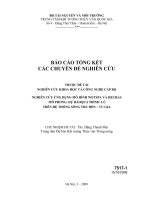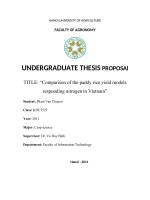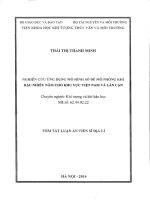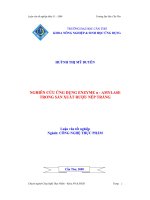Đề cương nghiên cứu ứng dụng mô hình trong sản xuất lúa gạo pps
Bạn đang xem bản rút gọn của tài liệu. Xem và tải ngay bản đầy đủ của tài liệu tại đây (190.48 KB, 11 trang )
HANOI UNIVERSITY OF AGRICULTURE
FACULTY OF AGRONOMY
UNDERGRADUATE THESIS PROPOSAl
TITLE: “Comparison of the paddy rice yield models
responding nitrogen in Vietnam”
Student: Pham Van Chuyen
Class: KHCT52T
Year: 2011
Major: Crop science
Supervisor: Dr. Vu Duy Binh
Department: Faculty of Information Technology
Hanoi - 2011
CHAPTER 1 - GENERAL INTRODUCTION
1.1 Introduction
Paddy rice is the most important crop of 5 main cereals in Vietnam. Not only
ensuring food security in Vietnam, rice production is as source of foreign currency
earnings of country. In 2009, rice production was grown in 7.4 million hectare area
and obtained 38.9 grain million tones. Exporting rice quantity was about 5.6
million tones, responsed 2.8 billion USD. While rice area hasn’t increased and
trends to decrease, increasing the rice productivity is essentially to ensure the food
security and exporting. To do it, rice production technology need to be provided as:
selecting the high yield varieties, irrigation management, fertilizers, pest
management, tillage In there, mostly the applied fertilizer quantities are derived
from field studies in which crop yield and quality responses to a range of fertilizer
rates are measured. Responses are often modeled to determine optimum fertilizer
rate. The lacks of these studies are economic efficiency and environment pollution
of over-fertilization. So, the fertilizer response yield mathematic models applied to
improve these lacks.
Some study shows nitrogen is the most important fertilizer factor that determines
the rice yield and is very interested in rice simulation models. Proportion between
applied nitrogen and yield are positive and depends on rice varieties, time, by soil
type, by cultural practice and by weather. It is very complex. Simulation ability of
the nitrogen response yield models is not complete accuracy and so, depends on
their functions.
Rice simulation models are developed from 1970s and are full-made gradually
with ORYZA2000, CERES-RICE, DSSAT, and APSIM These models integrated
of many modules that simulate all three different production situations (potential,
fertilizer, weather, soil, culture…). For the same module in the simulation model,
response can be appeared by difference mathematic models. Today, for nitrogen
response yield models, they usually have the forms: response curves were linear
(L), quadratic (Q), and linear with plateau (LP), quadratic with plateau (QP),
logistic (LO) functions. The good fit of the above equations to the observed data
appears at differently level. It is essential to evaluate the nitrogen response yield
models for paddy rice in Vietnam.
Purpose of the study is to compare the performance of the yield models for paddy
rice responding nitrogen in Vietnam and select the model having the best
performance. The study named “comparison of the paddy rice yield models
responding nitrogen in Vietnam”
1.2 Objectives and requirements
1.2.1 Objectives
To evaluate the good fit of the nitrogen response yield models for paddy rice
varieties in Vietnam.
To encourage the use of the best-performing model in the rice-nitrogen studies
To help in fertilization recommendations that result in optimum rice yield and
quality without risking over fertilization.
1.2.2 Requirements
Determine values and confident of the coefficients in the functions and interpret
their mean
Compare the predicted yield and the observed yield by Chi-square test
Evaluate affecting of their rice varieties for the minimum and maximum yield.
CHAPTER 2 - LITERATURE REVIEW
Nitrogen is the most important nutrient for rice and affect the yield an quality of
seed (Yoshida S, 1981). Rice cans uptake nitrogen from soil, applied fertilizer,
organic debris. When increasing the nitrogen fertilizer, yield can significantly.
Fertilizer introduction trends to optimize the rice yield. This usually causes the
environment pollution due to over-fertilizer and currently reduces the economic
profit. Application of mathematic model can solve the above problem. Linear (L),
quadratic (Q), and linear with plateau (LP), quadratic with plateau (QP) functions
are introduced to simulate the rice yield response fertilizer (Blackmer, 1990).
Linear model is proposed early. It is simply, easy to use. it describe the linearly
proportion between applied nitrogen and yield. In fact, with high nitrogen,
response yield doesn’t increase. The model is not significance at high nitrogen
To improve the limitation of the linear model, some study use combination of
linear and plateau equations to fit data.
Logistic model expressed the goodness of fit to foliage, vegetable crop response
nitrogen (Overman, A.R. and Scholtz, R.V. III, 2002). For cereal as maize, wheat,
barley, the application of logistic model in yield simulation responding nitrogen
also showed the good fit.
CHAPTER 3 - MATERIALS AND METHODS
3.1. Experimental site and duration
3.1.1 Experimental site
Experiment is conduct in the field at Faculty of Agronomy, Hanoi university of
Agriculture, Hanoi
3.1.2 Duration
Summer-autumn season in 2004
3.2 Methods
3.2.1 Materials
Materials consist of 3 rice varieties including 2 hybrids Vietlai 20, Bac Uu 903, 1
inbreeding CRD
There are 4 applied nitrogen fertilizer rates: 0, 60, 120, 180 kg N/ha. With each
dose of nitrogen were accompanied by an common dose 90 kg P
2
O
5
/ha and 60 kg
K
2
0/ha
The total of 4 fertilizer rate for 3 rice varieties (Vietlai 20, Bac Uu 903, CRD)
result to 12 experiment units. The experimental units were arranged in a random
block design with 3 replications and unit area is 15 m
2
.
The grain yield was measured at 14% moisture content
3.2.2 Yield model
3.2.2.1 Linear (L) model
The L function model is defined by the following equation.
Y = Y
0
+ bX [1]
Where Y = grain yield (tons/ha), X = fertilizer application rate (kg/ha), Y
0
= grain
yield at 0 nitrogen kg/ha, b = applied N coefficient for rice yield (tons/kg).
Constant b is obtained by fitting data to the model function
3.2.2.2 Quadratic (Q) model
The Q model is defined by the equation
Y = a + bX + cX2 [2]
Where Y is grain yield (tons/ha), X is fertilizer application rate (kg/ha), and a
(Intercept), b (linear coefficient), and c (quadratic coefficient) are constants
obtained by fitting data to the model function.
3.2.2.3 Linear with plateau (LP) model
(LP) model is described following
Y = a + bX if X < C [3]
Y = P if X ≥ C [4]
Where Y = grain yield (tons/ha), X = fertilizer application rate (kg/ha), a =
intercept parameter, b = applied N coefficient for rice yield (tons/kg), C =critical
fertilizer rate (kg/ha), which occurs at the intersection of the linear response and
the plateau lines), and P (plateau yield) is the constant obtained by fitting data to
the model function.
3.2.2.3 Quadratic with plateau (QP) model
The QP model is defined by following equations:
Y = a + bX + cX2 if X < C [5]
Y = P if X ≥ C [6]
Where Y is grain yield (tons/ha), X is fertilizer application rate (kg/ha), and a
(intercept), b (linear coefficient), and c (quadratic coefficient), C (critical fertilizer
rate, which occurs at the intersection of the quadratic response and the plateau
lines), and P (plateau yield) is the constant obtained by fitting data to the model
function
3.2.2.4 Logistic (LO) model
Logistic model was defined by following equation
[7]
Where Y=grain yield, N= applied nitrogen rate (kg/ha), A= maximum grain yield
at high nitrogen, b= intercept parameter, c= nitrogen response coefficient.
3.2.3 Analysis of variances (ANOVA)
For (1), (4), (6) equations, the plateau yield are defined as maximum yield at high
nitrogen and are estimate by virtual inspection.
The analysis of variance of the linear and quadratic equation are performed though
linear and quadratic regression respectively by SPSS v.16 of IPM Corporation
For the logistic model, the [7] equation is linearized to the form:
[8]
And [8] equation is linear with independent variance X and dependent variance It
is analyzed though linear regression by SPSS v.16 of IPM Corporation
3.2.4 Chi-square Test
Chi-square is a statistical test commonly used to compare observed data with data
we would expect to obtain according to the equations
Number of applied nitrogen fertilizer is 4
Degrees of Freedom is df=n-1=4-1=3
Critical values of X
2
at degree of freedom df=3 are respectively 90%, 95%, 99%
probability levels
X
2
3, 0.1
= 6.251
X
2
3, 0.05
= 7.815
X
2
3, 0.01
= 11.345
Comparing the calculated X
2
with critical value is to evaluate the probability level.
CHAPTER 5 - CONCLUSION AND RECOMMENDATION
CHAPTER 6 – REFERENCES
A. Dobermann, T.H. Fairhurst. (2000). Nutrient Disorders & Nutrient
Management. Singapo: Potash & Phosphate Institute (PPI), Potash & Phosphate
Institute of Canada (PPIC) and International Rice Research Institute (IRRI).
Blackmer, M. E. (1990). Comparison of Models for Describing; Corn Yield
Response to Nitrogen Fertilizer. Agron. J. 82:138-143.
Bouman BAM, Kropff MJ, Tuong TP, Wopereis MCS, ten Berge HFM, van Laar
HH. (2001). ORYZA 2000: modeling lowland rice. Mainila (Philipin): International
Rice Research Institute.
Dũng, N. T. (2007). kết quả ứng dụng hệ thống canh tác lúa (system of rice
intensification-sri) ở các vùng sinh thái phía bắc (2005-2006). Cục Bảo vệ thực vật
.
Frans R. Moormann and Nico van Breemen. (1978). Rice: Soil, Water, Land.
Manila , Philippines: International Rice Research Institute.
Garcia, A.G. y; Dourado-Neto, D.; Basanta, M. del V.; Ovejero, R.F.L.; Favarin,
J.L. (2003). Logistic rice model for dry matter and nutrient uptake (Vol. v. 60(3) ).
Scientia Agrícola.
Glantz, S. A. (2002). Primer of Biostatistics, 5th Edition. McGraw-Hill.
IRRI. (1987). Efficiency of nitrogen fertilizers for rice. Manila, Philipin:
International Rice Research Institute .
Kirkham. (2005). Principles of Soil and Plant Water Relations. Elsevier,
Amsterdam.
Mahdi, S. P. (2008). A Comparison of Three Mathematical Models of response to
Applied Nitrogen Using Spinach. Varamin: IDOSI Publications.
Mamaril, C. P. (1984). Increasing the efficiency of nitrogen fertilizer on rice.
Overman, A.R. and Scholtz, R.V. III. (2002). Mathematical Models of Crop
Growth and Yield. New York: Marcel Dekker AG.
Pham Van Cuong, Pham Thi Khuyen, and Pham thi Dieu. (2004). Affection of
Nitrogen fertilizer level on dry matter production at different growth stage and
grain yield of several F hybrid and inbred rice cultivars. Hanoi, Vietnam: Hanoi
university of Agricultural.
Priyadarshani, S. H. Renuka. the effect of plant nutrition on crop growth and water
balance elements in rainfed lowland rice (Oryza sativa L.). Los Baños, Laguna,
Philippines.
S.M. Haefele, K. Naklang, D. Harnpichitvitaya, S. Jearakongman, E. Skulkhu, P.
Romyen, S. Phasopa, S. Tabtim, D. Suriya-arunroj, S. Khunthasuvon, D.
Kraisorakul, P. Youngsuk, S.T. Amarante and L.J. Wade. (2005). Factors affecting
rice yield and fertilizer response in rainfed lowlands of northeast Thailand. Field
Crops Research 98 (2006) 39–51.
Trường Cao đẳng Tài nguyên và Môi trường Tp.HCM. (2010). Đất trồng lúa
nước.
Tuong TP, Kam SP, Wade L, Pandey S, Bouman BAM, Hardy B. (2000).
Characterizing and understanding rainfed environments. Proceedings of the
International Workshop on Characterizing and Understanding Rainfed
enviroment. Bali, Indonesia., Los Baños (Philippines): International Rice Research
Institute.
V. M. Chowdary, N. H. Rao and P. B. S. Sarma. A coupled soil water and nitrogen
balance model for flooded rice fields in India (Vol. 103). Agriculture, Ecosystems
& Environment.
Yang J., Greenwood D.J., Rowell D.L., Wadsworth G.A., Burns I.G. (2000).
Statistical methods for evaluating a crop nitrogen simulation model, N_ABLE.
Agricultural Systems .
Yoshida S. (1981). Fundamentals of rice crop science. Manila, Philippines:
International Rice Research Institute.









